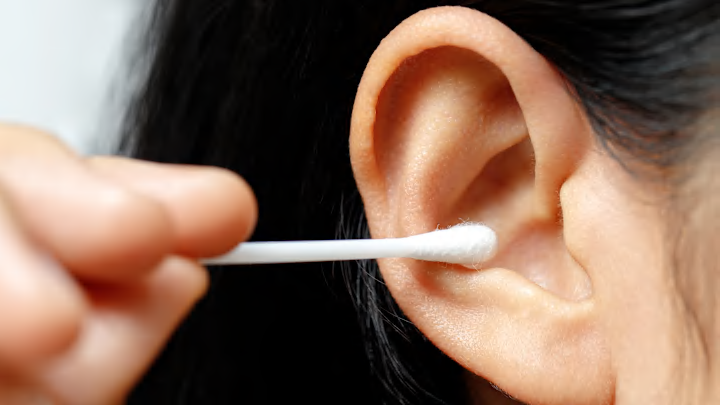If you want to keep your eardrum intact, sticking a Q-Tip in your ear is a bad idea. In 2017, the American Academy of Otolaryngology revised its guidelines for earwax care to advise against using cotton swabs; some Q-Tip packages even come with the same kind of warning. Despite that, people continue jamming sticks wrapped with cotton in their ears partly because it feels good. But what makes the sensation so addictive?
- Why Sticking Q-Tips in Your Ears Is Oddly Satisfying
- What Makes It So Dangerous?
- Safe Ear-Cleaning Methods to Try Instead
Why Sticking Q-Tips in Your Ears Is Oddly Satisfying
To get to the bottom of what makes the risky hygiene practice so pleasurable, it helps to understand how sensitive our ears are and how interconnected they are to other body parts. The ear canal is believed to be an erogenous zone, or an area that causes sexual arousal when touched. According to Seth Pross, an otolaryngologist at Johns Hopkins Medicine who spoke with Men’s Health about the subject, people may experience sensations in various regions—such as the heart, belly, or reproductive areas—when using a Q-Tip in the ear. This is thanks to the vagus nerve, a nerve bundle that spans from the brain to the large intestine, which the ears can stimulate.
Some people may be motivated by irritation and itchiness they feel inside their ears. In such cases, using a Q-Tip may be the only way to find relief. Other individuals might find cleaning their ear with a cotton swab pleasurable because the ear canal is a ticklish spot that usually can’t be touched.
What Makes It So Dangerous?

Although it may feel pleasant, health experts advise against using Q-Tips for good reason. Cotton swabs can push earwax further into the ear canal, causing impaction, a condition where built-up cerumen leads to symptoms such as discomfort, dizziness, and muffled hearing. Q-Tip usage can injure the eardrum and canal as well.
You May Also Like:
- The Best Way to Wipe Your Butt, According to the Experts
- You Probably Shouldn't Be Mouth Taping While You Sleep
- What’s Really in Floodwater—and Why It’s More Dangerous Than You Think
Safe Ear-Cleaning Methods to Try Instead
Instead of excavating wax from deep inside the ear canal, focus on cleaning the outer parts of the ear. Much of the earwax will naturally work its way through the ear as jaw movement occurs during chewing. With that in mind, you can probably get away with wiping the exterior of your ears with a towel every day after showering. If you’re dealing with excess wax buildup you need to clear out, try adding a few drops of either mineral oil, olive oil, or hydrogen peroxide to your ear canal and let the wax soften and slide out. You can also opt for over-the-counter earwax drops.
It’s also important to remember that some amount of wax is necessary for ear health. The substance prevents germs, dirt, water, and other irritants from entering the ear canal. Salus University Health explains that the ear is a self-cleaning part of the body and doesn’t require much maintenance. Over-cleaning can lead to dryness, itchiness, and irritation, which may lead to inflammation and infection.
Read More About the Body:
